Craving for Singaporean dishes? Have you ever tried Singapore’s meat delicacies? Food is seen as an essential part of Singapore’s national identity and a common cultural thread. Eating is made a national activity, and food is declared a national passion in Singaporean literature. Food is a popular topic of discussion among Singapore residents. There are also religious food limits in the place. Muslims cannot eat pork, Hindus cannot eat beef, and there are also large amount of vegetarian or vegan community. People from many groups frequently eat together, keeping in mind each other’s cultures and selecting delicious foods that are suitable for all.
Today, we are going to talk about the most popular meat recipes in Singapore. If you want to learn more about these delicious Singaporean dishes, scroll down and continue reading.
Singaporean Meat Dishes

Bak Kut Teh Or Pork Bone Tea
Bak kut teh is a pork rib meal prepared in broth that is popular in Singapore, where the Hoklo and Teochew communities coexist.
The Bak kut teh refers to “meat bone tea” in Hokkien dialect, and it consists of juicy pig ribs cooked for hours in a complex broth of herbs and spices, such as star anise, cinnamon, cloves, dong quai, fennel seeds, and garlic. Bak kut teh contains no tea, despite the name. The term relates to a strong oolong Chinese tea that is typically offered alongside the soup in the hopes of diluting or dissolving the large amounts of fat ingested from the pork ribs.
In Singapore, the Teochew version meal is prepared with a side of youtiao, which is chopped into little pieces and supposed to be dipped into the soup before eating. Braised pig trotters can be ordered as a side dish with the cuisine, and a dark soy sauce with chilli padi is recommended as a condiment. In restaurants that specialize in the meal, tea offered in a kung fu tea ceremony is also available.
Generally, bak kut teh is served for breakfast or lunch. Tea is a traditional part of the Hokkien and Teochew culture, and it is shown in their cuisines.

Char Kway Teow/Fried Flat Noodles
A type of stir-fried Chinese-inspired rice noodle dish, Char kway teow is from the Maritime Southeast Asia. The term Char refers to “stir-fried” in Hokkien and Teochew, and kway teow refers to flat rice noodles. It is created using 1 cm or 0.5 cm wide noodles (kway teow) stir-fried with garlic, light and dark soy sauce, chilli paste, whole prawns, shelled blood cockles, chopped Chinese chives, slices of Chinese sausage, and bean sprouts over extremely high heat. Sliced fish cake and belachan are two more common ingredients added.
Char kway teow is originally produced and served to overseas-born Chinese workers in Southeast Asia, the dish has gained great attentions throughout the area, particularly in Singapore and Malaysia, since the late twentieth century. However, because it is traditionally stir-fried in swine fat with crisp croutons of pork lard, the dish has earned a reputation for being not healthy in due to its high saturated fat content.
Char kway teow is an affordable famous dish provided at food vendors in Singapore. In normal hawker dishes, blood cockles and prawns are standard fare, but more expensive or gourmet versions include squid, cuttlefish, and lobster flesh. Yellow wheat noodles and flat rice noodles are combined in Singaporean char kway teow. Some cooks create healthier versions by adding more veggies and using minimal oil.

Yong Tau Foo
Tofu mixed with ground beef combination or fish paste is the main ingredient of Yong tau foo, a Hakka Chinese dish. Vegetables and mushrooms packed with ground beef or surimi are one variation of this dish. Yong tau foo can be consumed in a various ways, including dry with a sauce or as a soup.
It’s quite popular in Singapore and other Asian countries. When Yong Tau Foo debuted in Singapore, they made some unique alterations to the food’s filling ingredients. Singaporeans pack tofu with bitter melon, okra, fish cake/ball, or cuttlefish instead of the fish sauce-flavored minced meat.
2 Variations Of Yong Tau Foo
Fried Yong Tau Foo
Tofu cubes are filled and heaped with minced meat, such as lamb or pork, and seasonings, then fried till golden brown, or sometimes simmered, in traditional Hakka varieties of yong tau foo. Various condiments, such as shiitake mushrooms, eggplants, and bitter melon packed with the same beef mixture, are used as variations. Yong tau foo is traditionally served with bitter melon and shiitake variations in a clear yellow bean stew.
Soup Yong Tau Foo
The soup can include other ingredients such as fish balls, crab sticks, cuttlefish, sausages, and so on. The base of the meal is various types of tofu loaded with fish paste, but it is now usual to stuff vegetables such bitter melon, lady fingers, and chilis with fish paste as well. The ingredients are then chopped into bite-size pieces, boiled briefly in boiling stock, and offered as soup or in a separate bowl with the liquid (dry). The dish can be enjoyed alone or with a bowl of steaming rice, noodles, or rice vermicelli, and is served with chopsticks and a soup spoon. It is also best served with laksa gravy or curry sauce.
A hot, vinegary chili sauce, originally created from red fermented bean curd and tasting vaguely like Sriracha sauce, and a characteristic brown sweet bean sauce or hoisin for dipping sauce are essential additions.
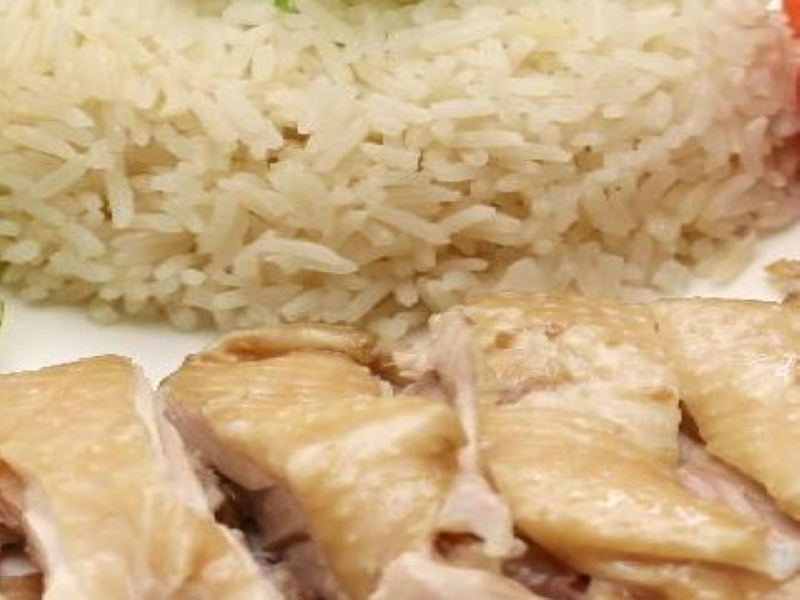
Hainanese Chicken Rice
Steamed chicken and seasoned rice are eaten with a chilli sauce and cucumber garnishes in Hainanese chicken rice. It was created from the Hainanese cuisine Wenchang chicken by immigrants from Hainan in southern China. It is known as one of Singapore’s national dishes and is most closely connected with Singaporean cuisine. The dish is also popular in Southeast Asia, particularly in Indonesia and Malaysia, where it is a mainstay of the cuisine.
Hainanese chicken rice originated in Singapore as a result of frugality, with servant-class immigrants seeking to preserve the flavor of the chicken.
When the British were driven out of Singapore during World War II and their Hainanese workers lost their income source, the first chicken rice restaurants were established. Yet Con, which debuted in the early 1940s, was one of the first. According to some sources, a street hawker named Wang Yiyuan decided to sell “chicken rice balls wrapped in banana leaves” in Singapore in the 1920s. Moh Lee Twee, whose Swee Kee Chicken Rice Restaurant served from 1947 to 1997, developed the dish in Singapore in the 1950s. Chua Lam, a Hong Kong cuisine critic, owes the dish’s conception to Moh.
Singapore’s national dish is Hainanese chicken rice, which can be eaten every day and everywhere in Singapore. The chicken is traditionally served with seasoned rice, chili sauce, and cucumber garnishes. While this Singaporean dish is most frequently connected with Singaporean cuisine, it can also be found in Southeast Asia and areas of the United States, where it is sometimes referred to as Singapore chicken rice. The dish is frequently available in hawker centers, restaurants, and hotels around Singapore.
The ingredients in making this dish are usually, chicken, sesame oil, soy sauce, cucumber, ginger, salt, scallions, and most especially rice. Although Hainanese chicken rice appears to be colorless and bland, it is actually quite good. It’s traditionally served with a dipping sauce made of chili sauce, kecap manis or sweet soy sauce, and ginger puree.
The chicken meat is cooked using traditional Hainanese techniques, which include poaching the entire chicken at sub-boiling temperatures to cook it and make the stock. After cooking, the chicken is immersed in ice to create a jelly-like skin finish and hung to dry.
The fat is removed from the stock, and part of the fat and liquid, as well as ginger, garlic, and pandan leaves, are incorporated in the rice’s cooking, resulting in an oily, flavorful rice known as oily rice. The rice, not the chicken, is the most significant aspect of chicken rice in Singapore.

Laksa
In Southeast Asia, laksa is a type of spicy noodle dish. Laksa is made out of a variety of noodles, the most common of which are thick rice noodles, and toppings such as chicken, prawns, or fish. A thick and spicy coconut milk curry or a broth seasoned with sour asam are used in most laksa varieties.
This noodle dish is from Peranakan cuisine and are popular in Singapore, Indonesia, and Malaysia.
There are many different types of laksa depending on the ingredients. Katong laksa is the most common type in Singapore. It is a form of curry laksa with a thickening gravy made from powdered dried shrimp. The sauce is slightly thinner than a typical curry, and it’s sprinkled with tofu and shredded chicken. Lemongrass leaves accent the dish, offering an aroma.
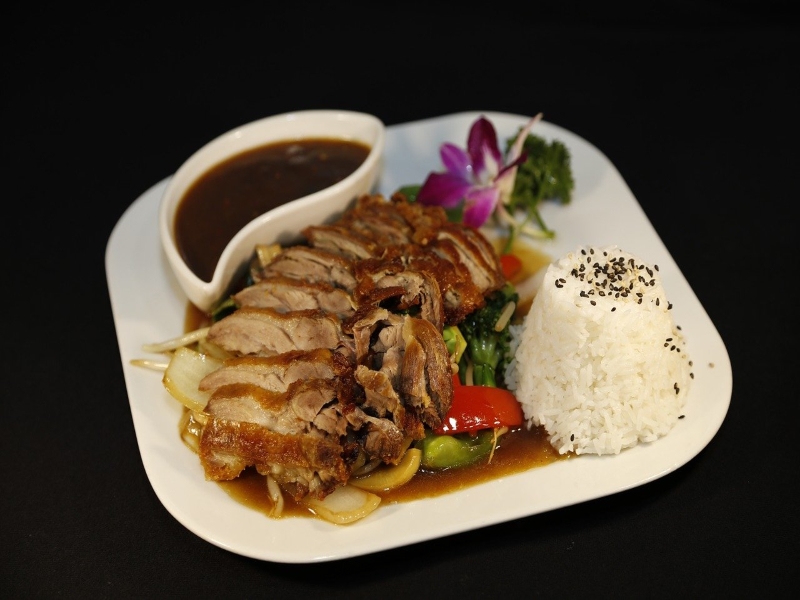
Ya Fan Or Duck Rice
Duck rice or Ya Fan, is a Southeast Asian meat dish made with plain white rice and either roasted or braised duck. Braised duck is commonly served with shrimp and yam, but it can also be prepared with plain white rice and a rich dark sauce, as well as side dishes such as braised hard-boiled eggs, haed beancurd, or preserved salted vegetables . Furthermore, Teochew boneless duck rice is a similar but refined dish, due to the slightly tougher texture of duck, the duck is craftily deboned and finely sliced for the ease and convenience of the diner, allowing the sauces to seep into the meat. Because of its popularity, Hainanese chicken rice and other similar dishes have followed this style.
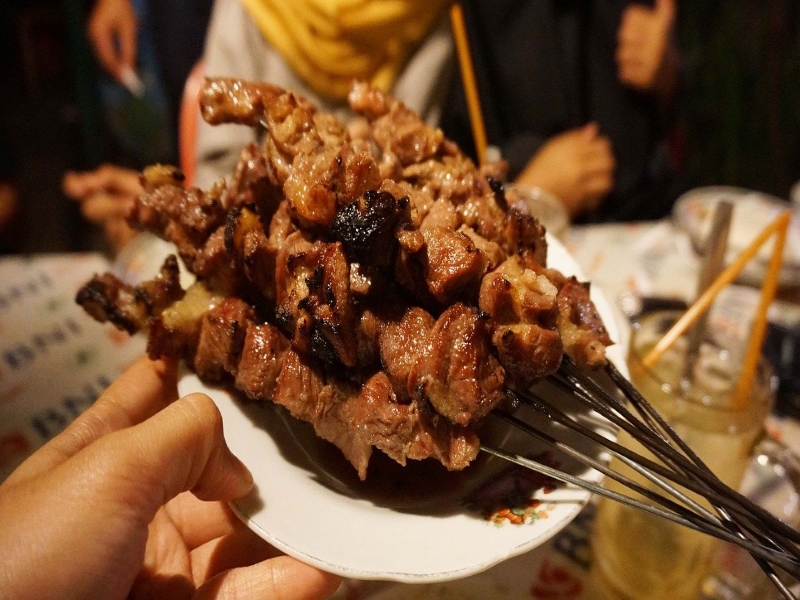
Satay
Satay can be made using diced or sliced chicken, goat, sheep, beef, hog, fish, other meats, or tofu. Bamboo skewers are commonly used, while skewers made from the midrib of a coconut palm frond are used in more rustic dishes. Satay is seasoned and skewered grilled meat served with onions, cucumbers, and rice cake alongside peanut sauce. This isn’t your typical grilled meat. The marinade and sweet soy sauce work together to give the meat a distinct Asian flavor.
Numerous competitive satay locations have now evolved in Singapore. Several stalls from the original Satay club have relocated to Sembawang in the city’s north, while the name has been transferred to the Clarke Quay site. The Lau Pa Sat area’s satay stalls are well-known for their fame. Boon Tat Street’s “Satay Street,” which opened in 1996, is based on ten hawkers selling satay. It resembles the open-air dining approach of prior establishments by only serving food after 7 p.m., when the street is closed to car traffic and the vendors and tables occupy the street.
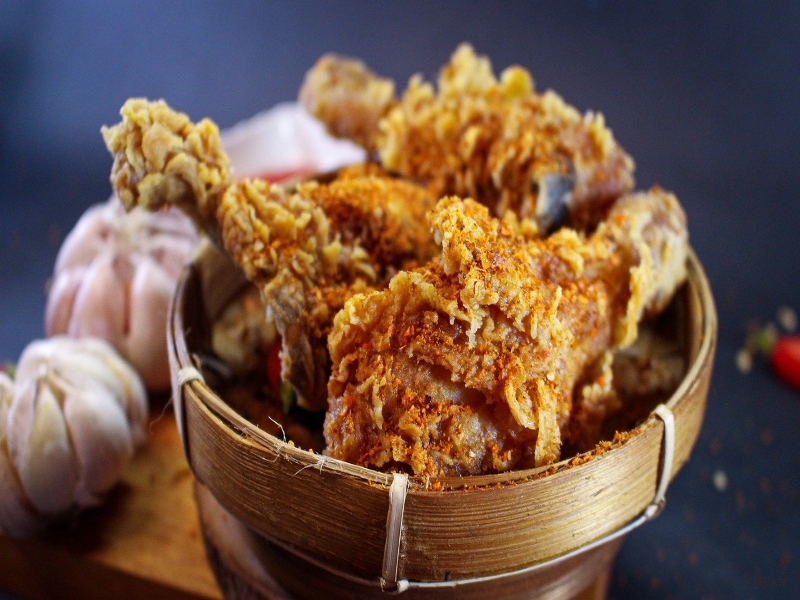
Har Cheong Gai
Har cheong gai, is a Singaporean fried chicken food made with fermented shrimp paste and chicken wings.
Har cheong gai, which is cooked with fermented shrimp paste/har cheong and a variety of other spices and seasonings, is one of Singapore’s most famous family fried chicken recipes. The shrimp paste used is a pinkish grey southeastern Chinese style, instead of the darker Malaysian style used for rojak sauce.
The main ingredients of this Singaporean dish are shrimp sauce, chicken mid wings, chinese wine, white pepper, ginger juice and garlic.
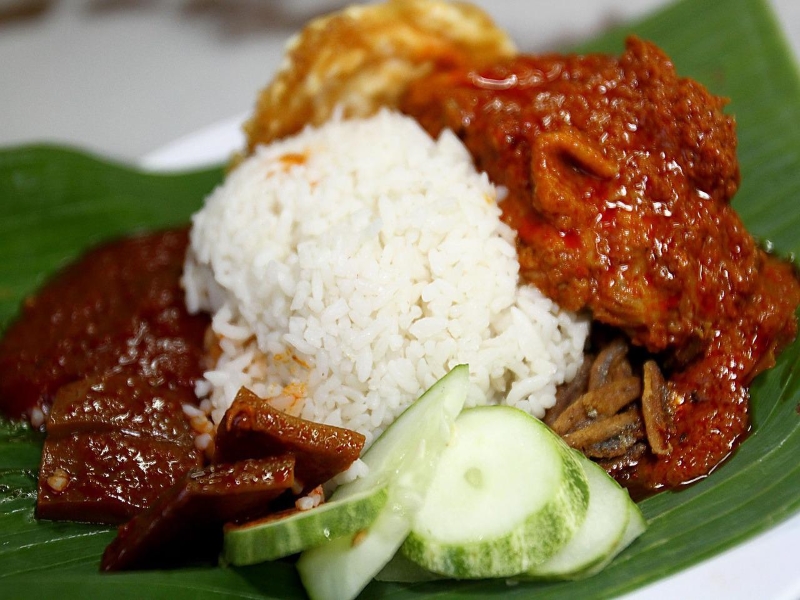
Nasi Lemak Or Singaporean Coconut Milk Rice
Nasi Lemak is actually a a popular Malay rice dish made with fragrant rice cooked in pandan leaves and coconut milk.. However, it is also the national dish of Singapore, Brunei, and Southern Thailand, all of which have considerable Malay populations.
In Malaysia and Singapore, nasi lemak is a popular dish. This famous dish is typically sold at hawker food centre and roadside booths in Malaysia and Singapore, and is more commonly enjoyed as breakfast in both countries.
Nasi lemak is prepared in various methods in Singapore and Malaysia, as chefs from all ethnicities make it. The original nasi lemak in Malaysia is undoubtedly a customary breakfast in Southern and Central Peninsular Malaysia, and it is thought to be of Malay origin. However, due to its widespread appeal, the meal has been recognized as a national food.
The Nasi Lemak in Singapore properly preserves the original thick and fatty flavor while distinguishing Singaporean cuisine.
Nasi Lemak’s rice is usually boiled with coconut milk and combined with pandan leaves, giving it a characteristic baby green tinge and a creamy, floral aroma.
Deep-fried fish or chicken wings, Otah or grilled fish cakes, Ikan Bilis or fried anchovies, peanuts, soft boiled eggs, fresh cucumber, and sambal or hot chili sauce or curry are all included in Nasi Lemak.
The Singaporean Chinese version, which preserves the familiar aroma of pandan leaves, is represented with a variety of sides, including deep fried drumstick, chicken franks, fish cake, curried vegetables, and tongsan luncheon meat. It can also be served simply with ikan bilis or anchovies, peanuts, and fried egg, as in the classic Malay version.
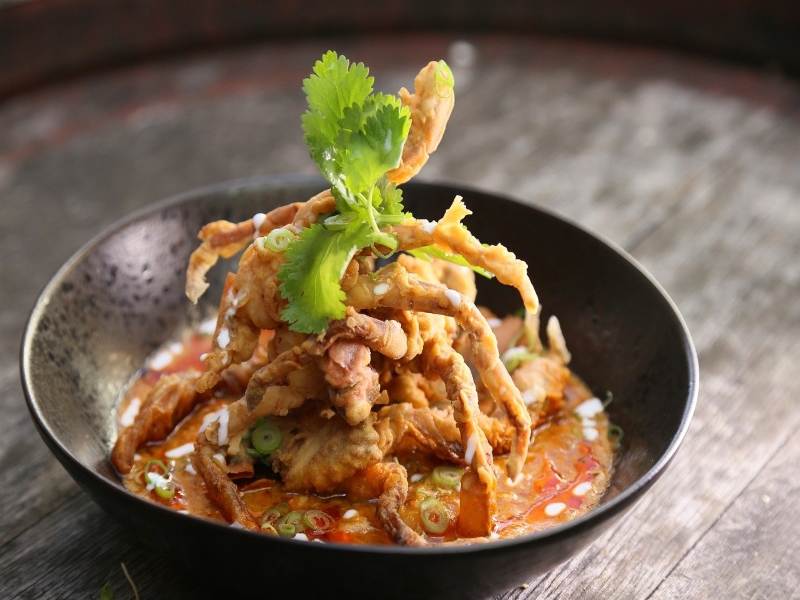
Chili Crab
Chili crab is a Singaporean seafood dish that dates back to the 1960s. It is well recognized as Malaysian and Singaporean national cuisines. Mud crabs are popular, and they’re stir-fried in a semi-thick, sweet-and-sour tomato-and-chilli sauce.
Chili crab sauce has a fluffy texture and is characterized as tangy and sweet, yet flavorful. The most popular type of crab used for the dish is mud crab/Scylla serrata, however other crab species can also be utilized.
Chilli crab is usually served with a side of fried or steamed mantou buns, which act as a vessel for scooping up the sauce. Chilli crab can also be eaten with crispy bread or fried dumplings. You may fully appreciate the delicious flavor by dipping the crispy bread or dumplings into the rich spicy sauce or some with salted eggs.
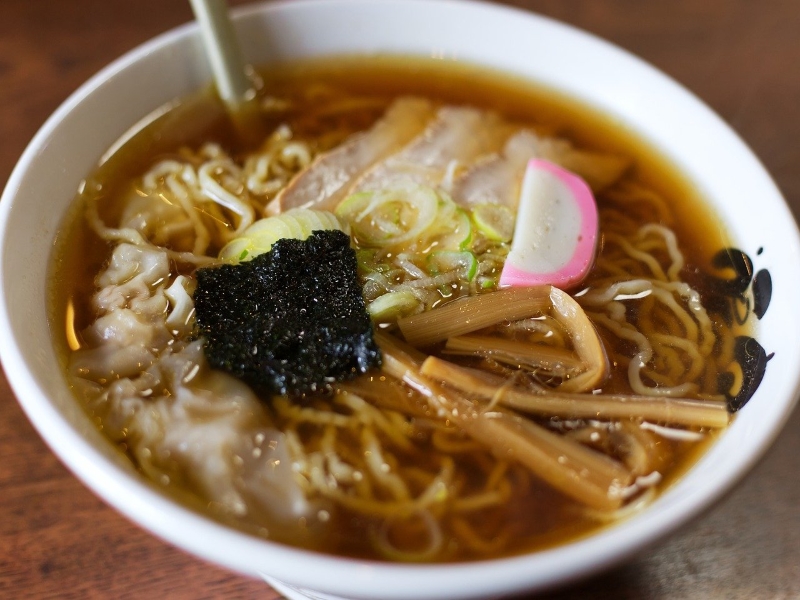
Wanton Mee Or Wonton Noodles
Yellow egg noodles, green veggies, particularly cai-xin, barbecued pork or char siu, and bite-sized dumplings or wonton, are the common ingredients to make Singapore wonton noodles. It is available in dry noodle dish or in soup form, with the former being the more popular option. If the wontons are served dry, they will be served in a separate bowl of soup. Some vendors sell shui jiao, or prawn dumplings, and Cantonese restaurants and noodle shops sell the traditional Hong Kong variety. Sometimes, instead of boiled wontons, fried wontons are offered, these wontons are deep-fried in oil. The wonton noodle is similar in Singapore and Malaysia, except the Singapore version uses substantially less soy sauce and is frequently served with chilli ketchup.
A small bowl of soup can be filled with pieces of roast pig and pork-stuffed dumplings that are fried or boiled, and served alongside this egg noodles.
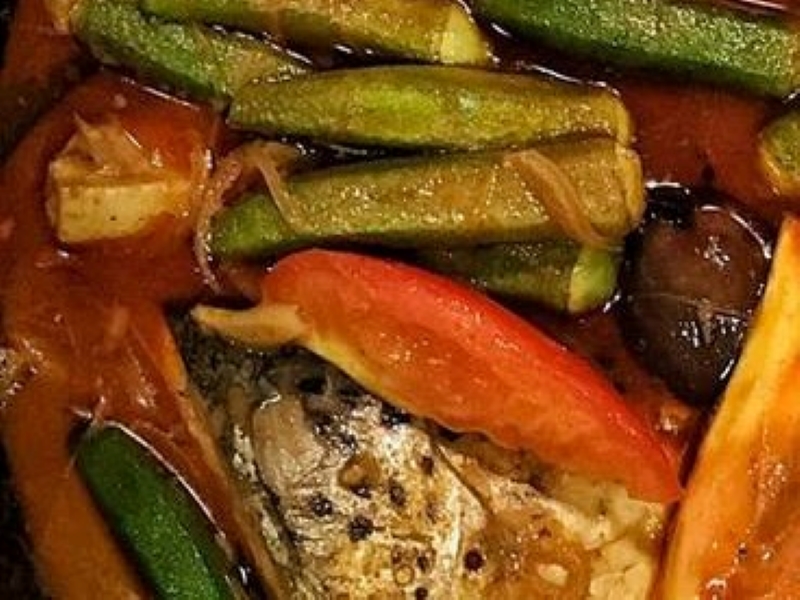
Fish Head Curry
Fish head curry is a Singaporean dish that is a blend between Indian and Chinese cuisines. A curry is made with the head of a red snapper and various veggies such as okra and eggplants. It’s generally eaten with rice or bread as a side dish, or as a shared meal.
M.J. Gomez, a chef from Kerala, came up with the idea for fish head curry in Singapore. He was residing in the nation at the time, sought to introduce local customers to the South Indian food. He opened a restaurant, and named it Gomez Curry, which was first located on Sophia Road and then on 9 Selegie Road in the Rochor district of the Central Region.
This dish is being served in restaurants around Singapore by people of various races. Fish head curry is a favorite dish among both Singaporeans and guests.
It is commonly sold in hawker centre and neighborhood food vendors, and is usually served in a clay pot. The sour-sweet flavor of the sauce pairs well with rice and/or naan bread.

Orh Jian Or Oyster Omelette
Orh jian is a famous Singaporean food stall dish that can be found at many hawker centers. Fresh raw oysters, tapioca starch, and eggs are used to make an oyster omelette.
Because influence of the Hokkien and Teochew community, the oyster omelette is a food of Hokkien and Teochew origin that is renowned for its savory flavor in its native Chaoshan and Minnan region, as well as Taiwan and many parts of Southeast Asia like the Singapore, Philippines, Thailand, and Malaysia.
The type of dish is made up of an omelette with a stuffing made up mostly of tiny oysters. The egg batter is thickened with starch, usually sweet potato starch, which gives the resulting egg wrap a firm texture. Pork lard is generally used to fry the omelet. A savory sauce may also be put on top of the omelette for added flavor, depending on regional variations.
To produce a strong kick, spicy or chile sauce combined with lime juice is commonly used. Shrimp can be used as a substitute of oysters on occasion. The dish is called shrimp omelette.
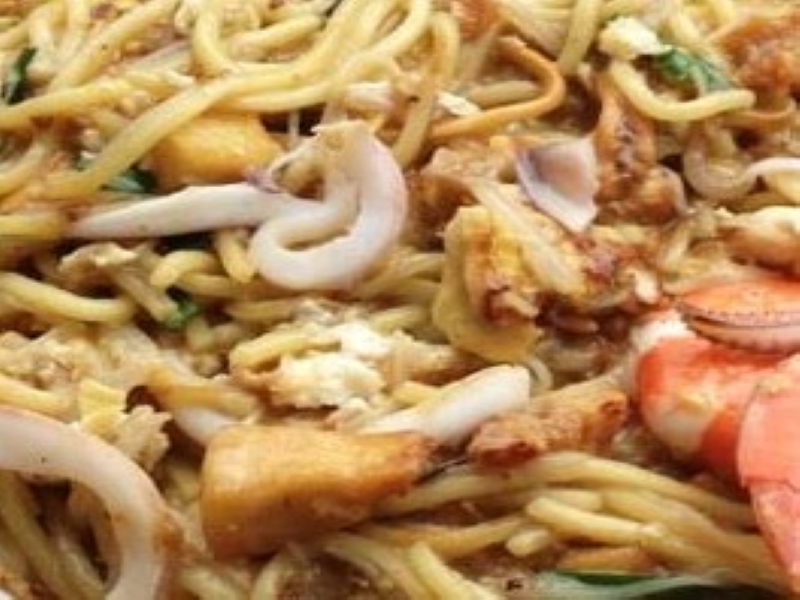
Hokkien Mee
This is a Chinese dish that originated in the Fujian (Hokkien), province of China. In Malaysia and Singapore, there are three distinct varieties of Hokkien mee.
Egg noodles and rice noodles are stir-fried with egg, pig slices, prawns, and squid, and served with veggies, sambal sauce, small chunks of fat, and lime in the Singaporean version. Prawns, pork ribs, fish cake, spring onions, squid, 0r chives are the most common toppings. Small cubes of fried lard were normally used, but it has not been used anymore, and chicken lard has been substituted due to health concerns. Certified Halal Hokkien mee is made with chicken and contains no pork or pork lard, making it suitable for Muslim consumption.

Popiah
Popiah is a type of spring roll that is originated in Fujian, China. It is a well-known street food in many parts of Asia, such as Singapore.
Popiah is a thin, pancake-like wrapper stuffed with different kinds of ingredients such as finely jicama, grated turnip, bean sprouts, and lettuce leaves and slathered with a sweet bean sauce. It can also be loaded with various ingredients such as crushed peanuts, fried tofu, minced pork, shredded omelette, shrimp, and crab, depending on the vendor.

Ngoh Hiang
Ngo hiang, also called as heh gerng, lor bak, or kikiam. It is a distinctive Hokkien and Teochew cuisine popular in some parts of Asia, like Singapore. It is originated in Southern China.
It is basically a combination of various meats, vegetables, and other ingredients, such as lup cheong, cucumber, century egg, ginger, deep-fried egg, deep-fried beancurd, fishball, a sausage-like roll consisting of minced pork and prawn or fish, seasoned with five-spice powder. It’s frequently served with chili sauce and a sweet sauce that’s unique to the restaurant. Fried bee hoon with ngo hiang is sold at many stalls in Singaporean food courts and hawker centres. This combination is well-known for breakfast and lunch. People in Indonesia eat ngo hiang with sambal sauce.
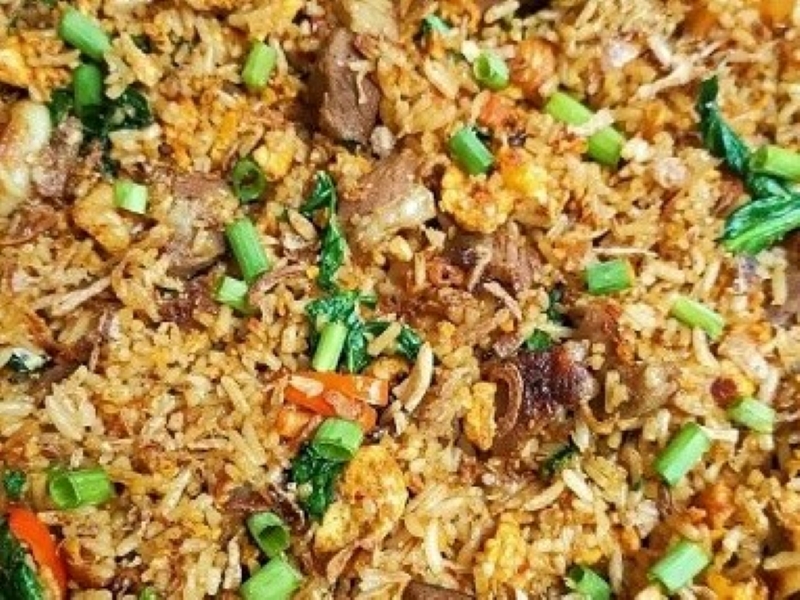
Nasi Goreng Kambing
Nasi goreng is a fried rice dish from Asia, generally made with meat and veggies. One of the national cuisines in Indonesia. It is prevalent in Malay-speaking cultures in nations such as Singapore.
Nasi goreng is distinctive from other Asian fried rice dishes by its smoky aroma and caramelized but savory flavor characteristics. There are a lot of recipes for nasi goreng, and the ingredients and methods of preparation differ widely from one place to another.
It is a dish consisting rice, minced mutton, chili peppers, shallots, carrots, garlic, cucumbers, ginger, oil, curry leaves, fish sauce, lime leaves, shrimp paste, cinnamon, coriander, cumin, sugar, turmeric, eggs, white vinegar, tomatoes, and salt.

Sup Tulang
Beef bones or mutton are cooked in a sweet and spicy red soup made with mutton stock, tomatoes, chilies, ginger, and spices to produce sup tulang. The marrow contained in the bones is valued in this dish. The meal is considered a local creation, despite its connection with the Indian Muslim minority. It is a traditional Singaporean dish.
Despite its color, sup tulang isn’t particularly hot. It’s less hot and more savory-sweet, and it’s paired with soft bread to soak up the sauce. The bread is perfect and delicious with the sauce.
Conclusion
With that said, these Singaporean traditional dishes will undoubtedly satisfy your hunger. They’re tasty, and they’re even better when shared with family and friends. Thank you for reading this post.

